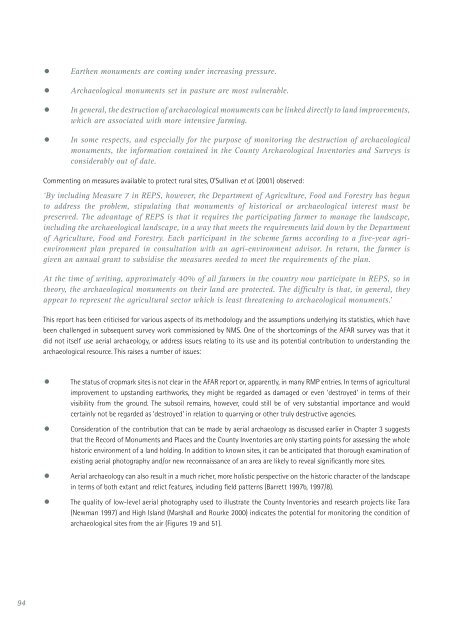Aerial Archaeology in Ireland - The Heritage Council
Aerial Archaeology in Ireland - The Heritage Council
Aerial Archaeology in Ireland - The Heritage Council
You also want an ePaper? Increase the reach of your titles
YUMPU automatically turns print PDFs into web optimized ePapers that Google loves.
94<br />
•<br />
•<br />
Earthen monuments are com<strong>in</strong>g under <strong>in</strong>creas<strong>in</strong>g pressure.<br />
Archaeological monuments set <strong>in</strong> pasture are most vulnerable.<br />
• In general, the destruction of archaeological monuments can be l<strong>in</strong>ked directly to land improvements,<br />
which are associated with more <strong>in</strong>tensive farm<strong>in</strong>g.<br />
• In some respects, and especially for the purpose of monitor<strong>in</strong>g the destruction of archaeological<br />
monuments, the <strong>in</strong>formation conta<strong>in</strong>ed <strong>in</strong> the County Archaeological Inventories and Surveys is<br />
considerably out of date.<br />
Comment<strong>in</strong>g on measures available to protect rural sites, O’Sullivan et al. (2001) observed:<br />
‘By <strong>in</strong>clud<strong>in</strong>g Measure 7 <strong>in</strong> REPS, however, the Department of Agriculture, Food and Forestry has begun<br />
to address the problem, stipulat<strong>in</strong>g that monuments of historical or archaeological <strong>in</strong>terest must be<br />
preserved. <strong>The</strong> advantage of REPS is that it requires the participat<strong>in</strong>g farmer to manage the landscape,<br />
<strong>in</strong>clud<strong>in</strong>g the archaeological landscape, <strong>in</strong> a way that meets the requirements laid down by the Department<br />
of Agriculture, Food and Forestry. Each participant <strong>in</strong> the scheme farms accord<strong>in</strong>g to a five-year agrienvironment<br />
plan prepared <strong>in</strong> consultation with an agri-environment advisor. In return, the farmer is<br />
given an annual grant to subsidise the measures needed to meet the requirements of the plan.<br />
At the time of writ<strong>in</strong>g, approximately 40% of all farmers <strong>in</strong> the country now participate <strong>in</strong> REPS, so <strong>in</strong><br />
theory, the archaeological monuments on their land are protected. <strong>The</strong> difficulty is that, <strong>in</strong> general, they<br />
appear to represent the agricultural sector which is least threaten<strong>in</strong>g to archaeological monuments.’<br />
This report has been criticised for various aspects of its methodology and the assumptions underly<strong>in</strong>g its statistics, which have<br />
been challenged <strong>in</strong> subsequent survey work commissioned by NMS. One of the shortcom<strong>in</strong>gs of the AFAR survey was that it<br />
did not itself use aerial archaeology, or address issues relat<strong>in</strong>g to its use and its potential contribution to understand<strong>in</strong>g the<br />
archaeological resource. This raises a number of issues:<br />
• <strong>The</strong> status of cropmark sites is not clear <strong>in</strong> the AFAR report or, apparently, <strong>in</strong> many RMP entries. In terms of agricultural<br />
improvement to upstand<strong>in</strong>g earthworks, they might be regarded as damaged or even ‘destroyed’ <strong>in</strong> terms of their<br />
visibility from the ground. <strong>The</strong> subsoil rema<strong>in</strong>s, however, could still be of very substantial importance and would<br />
certa<strong>in</strong>ly not be regarded as ‘destroyed’ <strong>in</strong> relation to quarry<strong>in</strong>g or other truly destructive agencies.<br />
• Consideration of the contribution that can be made by aerial archaeology as discussed earlier <strong>in</strong> Chapter 3 suggests<br />
that the Record of Monuments and Places and the County Inventories are only start<strong>in</strong>g po<strong>in</strong>ts for assess<strong>in</strong>g the whole<br />
historic environment of a land hold<strong>in</strong>g. In addition to known sites, it can be anticipated that thorough exam<strong>in</strong>ation of<br />
exist<strong>in</strong>g aerial photography and/or new reconnaissance of an area are likely to reveal significantly more sites.<br />
• <strong>Aerial</strong> archaeology can also result <strong>in</strong> a much richer, more holistic perspective on the historic character of the landscape<br />
<strong>in</strong> terms of both extant and relict features, <strong>in</strong>clud<strong>in</strong>g field patterns (Barrett 1997b, 1997/8).<br />
• <strong>The</strong> quality of low-level aerial photography used to illustrate the County Inventories and research projects like Tara<br />
(Newman 1997) and High Island (Marshall and Rourke 2000) <strong>in</strong>dicates the potential for monitor<strong>in</strong>g the condition of<br />
archaeological sites from the air (Figures 19 and 51).

















